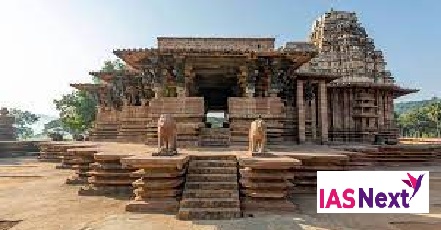CURRENT AFFAIRS
Get the most updated and recent current affair content on Padhaikaro.com
Ramappa temple: Telangana’s first UNESCO World Heritage Site
- IAS NEXT, Lucknow
- 29, Nov 2021

Context:
Telangana’s Ramappa Temple is receiving massive focus after it received UNESCO tag recently.
About the Temple:
- Situated in Telangana’s Warangal, the temple stands on a six-feet high star-shaped platform with walls, pillars and ceilings adorned with intricate carvings that attest to the unique skill of the Kakatiyan sculptors.
- The temple is named after its architect, Ramappa.
- Constructed in 1213 AD during the reign of the Kakatiya Empire by Recharla Rudra, a general of Kakatiya king Ganapati Deva.
- The temple’s presiding deity is Ramalingeswara Swamy.
About Kakatiya dynasty-Key facts:
The 12th and the 13th centuries saw the emergence of the Kakatiyas.
They were at first the feudatories of the Western Chalukyas of Kalyana, ruling over a small territory near Warangal.
- The dynasty saw powerful leaders like Ganapathi Deva and Rudramadevi.
- Prataparudra I, also known as Kakatiya Rudradeva, was the son of the Kakatiya leader Prola II. It was under his rule that the Kakatiyas declared sovereignty. He ruled the kingdom till 1195 A.D.
- It was under the rule of Prataparudra I that usage of Telugu language in inscriptions began.
- Before the establishment of Orugallu/Warangal as the capital, Hanamakonda was the first capital of the Kakatiyas.
- The great Italian traveller Marco Polo visited the Kakatiya Kingdom sometime during Rudramadevi’s tenure as the ruler of the Kakatiya Dynasty and made note of her administrative style; admiring her extensively.
Art and architecture:
- The iconic Kakatiya Thoranam was built by Rudramadevi’s father in the 12th Century. This ornate arch is said to have many similarities with the gateways at the Sanchi Stupa and is also the emblem of Telangana.
- The scenic Pakhal lake in Warangal was built by Ganapathi Deva.
- The 1000 pillar temple in Warangal was built during the Kakatiya Rule and is another example to the exquisite Kakatiya Architecture.
- The Koh-i-Noor Diamond, which is now among the jewels set in the British Crown, was mined and first owned by the Kakatiya Dynasty.
Society:
Under the Kakatiya rule, the caste system was not rigid and in fact, it was not given much significance socially. Anyone could take up any profession and people were not bound to an occupation by birth.
The Kakatiya rule finally came to an end in 1323 A.D. when Warangal was conquered by the Ghiyasuddin Tughlaq, the then Sultan of Delhi.